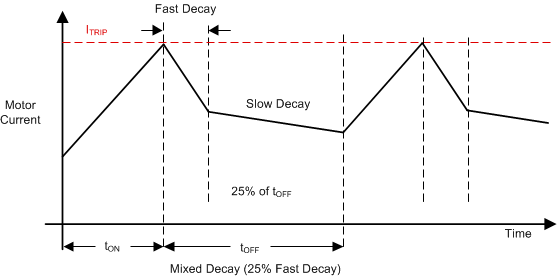SLVSE65C July 2018 – December 2023 DRV8847
PRODUCTION DATA
- 1
- 1 Features
- 2 Applications
- 3 Description
- 4 Revision History
- 5 Pin Configuration and Functions
- 6 Specifications
-
7 Detailed Description
- 7.1 Overview
- 7.2 Functional Block Diagram
- 7.3
Feature Description
- 7.3.1 PWM Motor Drivers
- 7.3.2 Bridge Operation
- 7.3.3 Bridge Control
- 7.3.4 Current Regulation
- 7.3.5 Current Recirculation and Decay Modes
- 7.3.6 Torque Scalar
- 7.3.7 Stepping Modes
- 7.3.8 Motor Driver Protection Circuits
- 7.4 Device Functional Modes
- 7.5 Programming
- 7.6
Register Map
- 7.6.1 Slave Address Register (Address = 0x00) [reset = 0x60]
- 7.6.2 IC1 Control Register (Address = 0x01) [reset = 0x00]
- 7.6.3 IC2 Control Register (Address = 0x02) [reset = 0x00]
- 7.6.4 Slew-Rate and Fault Status-1 Register (Address = 0x03) [reset = 0x40]
- 7.6.5 Fault Status-2 Register (Address = 0x04) [reset = 0x00]
-
8 Application and Implementation
- 8.1 Application Information
- 8.2
Typical Application
- 8.2.1 Stepper Motor Application
- 8.2.2 Dual BDC Motor Application
- 8.2.3 Open Load Implementation
- Power Supply Recommendations
- 9 Layout
- 10Device and Documentation Support
- 11Mechanical, Packaging, and Orderable Information
Package Options
Refer to the PDF data sheet for device specific package drawings
Mechanical Data (Package|Pins)
- PW|16
- PWP|16
- RTE|16
Thermal pad, mechanical data (Package|Pins)
Orderable Information
7.3.5 Current Recirculation and Decay Modes
During PWM current trip operation, the H-bridge is enabled to drive current through the motor winding until the trip threshold of the current regulation is reached. After the trip current threshold is reached, the drive current is interrupted, but, because of the inductive nature of the motor, the current must continue to flow for some time. This continuous flow of current is called recirculation current. A mixed decay allows better current regulation by optimizing the current ripple by using fast and slow decay.
Mixed decay is a combination of fast and slow decay modes. In fast decay mode, the anti-parallel diodes of the opposite FETs are conducting on to let the current decay faster as shown in Figure 7-12 (see case 2). In slow decay mode, the winding current is recirculated by enabling both low-side FETs in the bridge (see case 3 in Figure 7-12). Mixed decay starts with fast decay, and then goes to slow decay. In the DRV8847 device, the mixed decay ratio is 25% fast decay and 75% slow decay as shown in Figure 7-13.
 Figure 7-12 Decay Modes
Figure 7-12 Decay Modes Figure 7-13 Mixed Decay
Figure 7-13 Mixed DecayThe current regulation scheme uses a single sense resistor and hence always works for two-half bridges even when used in an "Independent Bridge Interface". It is recommended that current regulations not be used for loads using independent half bridges.